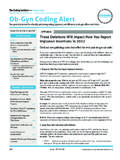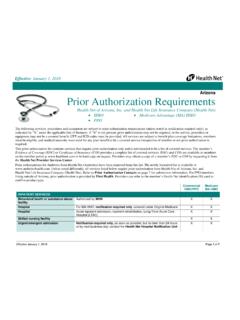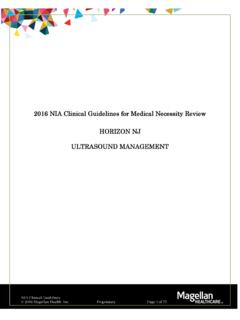Transcription of National Imaging Associates, Inc. ABDOMEN/PELVIS CTA ...
1 National Imaging Associates, Inc. Clinical guideline ABDOMEN/PELVIS CTA Original Date: September 1997 Page 1 of 5 CPT Codes: 74174 Last Review Date: June 2015 Guideline Number: NIA_CG_069 Last Revised Date: June 2015 Responsible Department: Clinical Operations Implementation Date: January 2016 1 ABDOMEN/PELVIS CTA 2016 Proprietary INTRODUCTION: Computed tomographic angiography (CTA) is used in the evaluation of many conditions affecting the veins and arteries of the abdomen and pelvis or lower extremities.
2 This study ( ABDOMEN/PELVIS CTA) is useful for evaluation of the arteries/veins in the peritoneal cavity (abdominal aorta, iliac arteries) while the Abdominal Arteries CTA is more useful for the evaluation of the abdominal aorta and the vascular supply to the legs. It is not appropriate as a screening tool for asymptomatic patients without a previous diagnosis. INDICATIONS FOR ABDOMEN/PELVIS CTA: For evaluation of known or suspected abdominal vascular disease: For known large vessel diseases (abdominal aorta, inferior vena cava, superior/inferior mesenteric, celiac, splenic, renal or iliac arteries/veins), , aneurysm, dissection, arteriovenous malformations (AVMs), and fistulas, intramural hematoma, and vasculitis.
3 Evidence of vascular abnormality seen on prior Imaging studies. For suspected aortic dissection. Evaluation of suspected or known aortic aneurysm**: Suspected or known aneurysm > cm AND equivocal or indeterminate ultrasound results OR Prior Imaging ( ultrasound) demonstrating aneurysm > cm in diameter and OR Suspected complications of known aneurysm as evidenced by sign/symptoms such as new inset of abdominal or pelvic pain. Suspected retroperitoneal hematoma or hemorrhage. Venous thrombosis (for CT Venogram) if previous studies have not resulted in a clear diagnosis.
4 Vascular invasion or displacement by tumor. Pre-operative evaluation: Evaluation of interventional vascular procedures for luminal patency versus restenosis due to conditions such as atherosclerosis, thromboembolism, and intimal hyperplasia. Post- operative or post-procedural evaluation: Evaluation of endovascular/interventional abdominal vascular procedures for luminal patency versus restenosis due to conditions such as atherosclerosis, thromboembolism and intimal hyperplasia. Evaluation of post-operative complications, pseudoaneurysms, related to surgical bypass grafts, vascular stents and stent-grafts in the peritoneal cavity.
5 2 ABDOMEN/PELVIS CTA 2016 Proprietary Follow-up for post-endovascular repair (EVAR) or open repair of abdominal aortic aneurysm (AAA). Routine, baseline study (post-op/intervention) is warranted within 1-3 months. o Asymptomatic at six (6) month intervals, for two (2) years. o Symptomatic/complications related to stent graft more frequent Imaging may be needed. Follow-up study may be needed to help evaluate a patient s progress after treatment, procedure, intervention or surgery. Documentation requires a medical reason that clearly indicates why additional Imaging is needed for the type and area(s) requested.
6 ADDITIONAL INFORMATION RELATED TO ABDOMEN/PELVIS CTA: Abd/ pelvis CTA & Lower Extremity CTA Runoff Requests: Only one authorization request is required, using CPT Code 75635 Abdominal Arteries CTA. This study provides for Imaging of the abdomen , pelvis and both legs. The CPT code description is CTA aorto-iliofemoral runoff; abdominal aorta and bilateral ilio-femoral lower extremity runoff. Bruits - blowing vascular sounds heard over partially occluded blood vessels. Abdominal bruits may indicate partial obstruction of the aorta or other major arteries such as the renal, iliac, or femoral arteries.
7 Associated risks include but are not limited to; renal artery stenosis, aortic aneurysm, atherosclerosis, AVM, or coarctation of aorta. Peripheral Artery Disease (PAD) Before the availability of computed tomography angiography (CTA), peripheral arterial disease was evaluated using CT and only a portion of the peripheral arterial tree could be imaged. Multi-detector row CT (MDCT) overcomes this limitation and provides an accurate alternative to CT and is a cost-effective diagnostic strategy in evaluating PAD. Abdominal Arteries CTA (including runoff to the lower extremities) is the preferred study when evaluation of arterial sufficiency to the legs is part of the evaluation CTA and Abdominal Aortic Aneurysm Endovascular repair is an alternative to open surgical repair of an abdominal aortic aneurysm.
8 It has lower morbidity and mortality rates and is minimally invasive. In order to be successful, it depends on precise measurement of the aneurysm and involved vessels. CTA with 3D reconstruction is useful in obtaining exact morphologic information on abdominal aortic aneurysms. CTA is also used for the detection of postoperative complications of endovascular repair. CTA and Abdominal Aortic Aneurysm ** The normal diameter of the suprarenal abdominal aorta is cm and that of the infrarenal is Aneurysmal dilitation of the infrarenal aorta is defined as diameter >/= cm or dilitation of the aorta >/= the normal diameter.
9 Recommended intervals for initial follow-up Imaging of ectatic aortas and abdominal aortas (follow up intervals may vary depending on comorbidities and the growth rate of the aneurysm): cm: ..5yr cm:.. 3yr cm:..2yr cm:..1yr 3 ABDOMEN/PELVIS CTA 2016 Proprietary mo cm:..3-6 mo CTA and Renal Artery Stenosis Renal artery stenosis is the major cause of secondary hypertension. It may also cause renal insufficiency and end-stage renal disease. abdomen CTA (limiting evaluation to the aorta above the bifurcation and including the abdominal arteries) is the preferred study.
10 Atherosclerosis is one of the common causes of this condition, especially in older patients with multiple cardiovascular risk factors and worsening hypertension or deterioration of renal function. CTA is used to evaluate the renal arteries and detect renal artery stenosis. 4 ABDOMEN/PELVIS CTA 2016 Proprietary REFERENCES American College of Radiology. (2014). ACR Appropriateness Criteria Retrieved from Kranokpiraksa, P., & Kaufman, J. (2008). Follow-up of endovascular aneurysm repair: plain radiography, ultrasound, CT/CT angiography, MR Imaging /MR angiography, or what?







